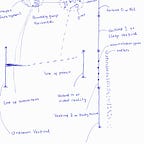Brain Science, Covert Consciousness, Coma and Mental Health
There is a recent piece in Scientific American, Some People Who Appear to Be in a Coma May Actually Be Conscious, explaining how those people have what is called covert consciousness, “a state in which the brain reacts to the outside world with some comprehension, although the body does not respond.”
The article, though excellent, follows a dominant approach in neuroscience, to understand the brain for a condition, rather than to understand the brain for what it is, then how that condition fits.
Conceptually, there is no difference between how the brain decides for mental health and how it does for coma, sleep or general anesthesia. Brain fractionalization has existed for a long time, dominating approaches to understanding functions.
However, it has in part deepened the complexity of the brain. There are sophisticated studies on memory, yet they do nothing for mental health. There are those on depression, yet they do nothing for learning. There are those on coma, yet they do nothing for anxiety, and so on.
The acceleration of brain science with interconnection for centralization of the brain would have been more helpful than the continuous divisions in research.
There are amazing works in consciousness, yet they don’t apply to mental health. Mental health, which should be the receptionist case of the brain, has gotten lost in unknowns, with assumptions everywhere on what helps or affects it, when there are studies in brain science, that if they had been properly adjusted, would have made a difference.
The brain has constants. The constants include quantities. The quantities acquire properties.
This reduction encompasses the entirety of the brain. There is no condition where this does not fit. And with this, connections could be made across studies, to improve the benefits or applicability of results.
Internal senses are known to report to the brain as signals. External senses are described as inputs. They are all processed similarly into quantities that relay to destinations for what they should do, or properties they have to acquire.
The properties have degrees that vary experiences. It is the brain that gives the experience or meaning of things, or what it is, how it does, to what extents all as quantities in property areas.
It often feels like something is somewhere or happening somewhere in the body but it is the brain that tells where, how and what. It is the quantities and properties in the brain that merges mind and body.
Covert consciousness in coma means that sensory input went through the regular channels, becoming a quantity and acquiring a property but to a lesser degree. The same is true under general anesthesia, or while asleep. Though with sleep, there could be a certain sound, waking up in fear immediately. This means the quantity acquired the property to a high degree. Sometimes, for some, it does not.
It is these constants that everything is subject to, in diseases, consciousness, mental health, learning and education and so on.
How can treatment, therapy and methods lay how quantities can better acquire desired properties, so that it is not just to rely on EEG or fMRI, but for probability of recovery towards curing coma?
This is the same for mental health, substance abuse, prevention of auto immune diseases [which is like the quantity for control did not acquire the properties to the degree it should, so the immune cells ran wild].
Quantities are postulated to be thought or their form. Properties are memory, extending to feelings and reaction. There is what it is to feel-like fear or to know what fear is, or cold, or hot when it is not externally experienced. There is also what it is to experience it when it is externally experienced. One may lead to the other across situations, but they are all properties.
Control or regulation of internal senses is also properties that give limits and extents of functions. The blood vessels at a normal pressure are regulated within limits and extents, or memory. In general, just like remembering is a property acquired, with a new or old sequence, so can control or regulation be forgotten, causing problems.
There are also properties that override others regardless of the molecules secreted. Desire may not be followed, no matter how strong, if the consequences at that time would be great. Cells and molecules of the brain build these quantities and properties for experiential interactions.
In brain science, all senses, internal and external come in to the brain stem and the thalamus, except for smell that comes into the olfactory bulb. It is where they are integrated or processed before relay to the cerebral cortex for interpretation.
Sensory processing is theorized to be into a uniform unit or quantity which is thought or a form of thought. This is how the brain creates the mind. And it is the form of thought that representation or equivalent of whatever is elsewhere is built, for acceptance, admission and use in the brain. Everything exists in the form of thought to the brain, the car, house, chair and so on. The liver, kidney and so forth are also regulated in the form of thought.
Thought as the quantity is what goes into the cerebral cortex for interpretation, postulated as knowing, feeling and reaction, which are the triad of properties, across the brain.
There are splits, sequences, small and large stores, prioritization, pre-prioritization, principal spots, slices across memory locations determining the how, what, where, when and which properties the quantity acquires.
The brain is not different for sleep and for running. The quantities and properties act differently, but they do so with the same mechanisms for all.
